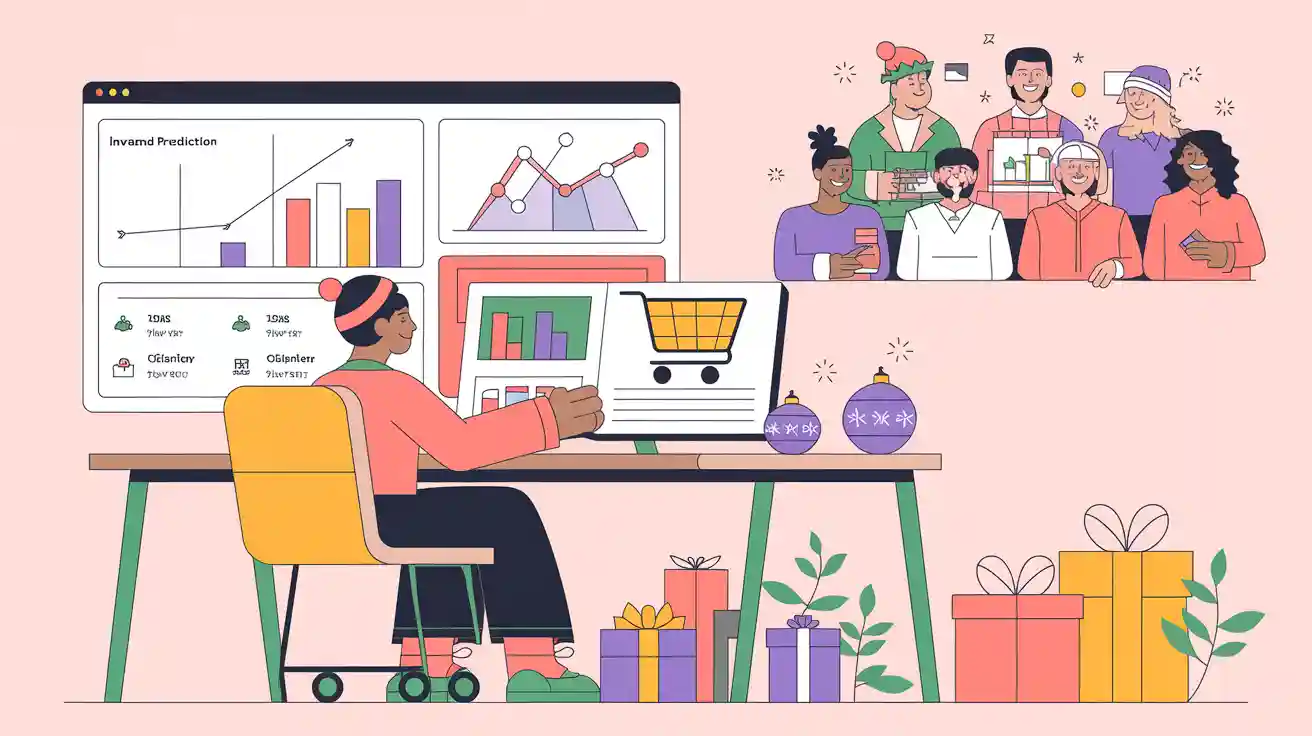The 2025 Holiday Inventory Hack: Use Data to Predict Demand and Win Customer Trust

If you want to win the holiday season in 2025, you need to trust the power of data. AI and analytics now help you spot sales trends, fix errors, and adapt to what shoppers want—even when things change fast. Retailers using these tools see fewer stockouts and more happy customers. Holiday Inventory Hack is not just a buzzword; it means you use smart forecasting instead of guesswork. Ready to leave old habits behind?
Key Takeaways
Use data and AI tools to guess holiday demand. Do not just guess or use manual spreadsheets.
Stop running out of stock or having too much by watching sales in real time. Change your inventory fast when you need to.
Mix old sales, market trends, and customer behavior data for better planning.
Pick software that works for your store. Teach your team how to use it well.
Use automatic forecasting to make fewer mistakes and save time during busy holidays.
Make customers happy by showing live inventory online. Deliver orders when you promise.
Be ready for surprises by testing scenarios. Move products between stores when needed.
Good data and quick actions help customers trust you. This can help you sell more during the holidays.

Holiday Inventory Hack: Why Old Methods Fail
Manual Forecasting Pitfalls
Some people think they can use spreadsheets and guesswork for holiday inventory. But this often causes problems. Manual forecasting uses old sales numbers and slow planning. You might not notice new shopping trends or sudden changes in demand. Typing numbers by hand can lead to mistakes. These mistakes can mess up your whole inventory plan. If you use old tools, you cannot see your stock right away. This makes it hard to act fast when something sells out or becomes popular.
Tip: To avoid these problems, check how you collect and track sales data. Even small mistakes can get bigger during the busy holiday season.
Here are some reasons manual methods do not work well:
You use old data that is not always right, so your forecasts are bad.
Planning takes a long time and can have errors.
You cannot see your inventory right away, so you miss fast trends.
Mistakes from typing numbers can cause stockouts or too much stock.
Teams that do not work together make planning harder.
You cannot react fast to things like weather or supply chain problems.
The Holiday Inventory Hack means using better and faster tools instead of old ways.
Stockouts and Overstock Risks
Stockouts and overstocking are both big problems. If you run out of a popular item, you lose sales and upset customers. If you buy too much, you waste money on storage and discounts. In 2023, inventory mistakes cost stores $1.77 trillion, which is about 7.2% of all retail sales. Stockouts make you pay more for fast shipping or lose shoppers to other stores. Overstocking uses up your money and fills your warehouse with things you cannot sell. Both problems hurt your profits and your store’s reputation.
Here are some things that can go wrong:
Manual mistakes cause wrong stock numbers.
Bad communication slows down reordering.
You cannot guess when demand will spike, so you run out or overbuy.
Too much stock means higher storage costs and more discounts.
Stockouts mean lost sales and unhappy customers.
The Holiday Inventory Hack helps you fix these problems by using data and automation to keep your stock just right.
Rising Customer Expectations
Customers want more from you during the holidays. They want to find what they need, when they need it, both online and in stores. Shoppers now make fewer trips but know what they want. They expect you to have the right products at the right time. If you do not, they will shop somewhere else. People also want to check your inventory online before they visit. They want fast and reliable service.
Note: The holiday season is longer now, and customers want steady inventory, not just on Black Friday but all season.
If you cannot meet these needs, you might lose loyal customers. The Holiday Inventory Hack gives you the tools to keep up and earn trust with every sale.
Data-Driven Demand Forecasting
You want your holiday inventory to be right. Data-driven demand forecasting helps you do better. Smart tools and real numbers show what customers want. You can predict what people will buy and when. Let’s see how data helps you make good choices this holiday.
Using Historical Sales
Start by looking at your old sales. Your sales history tells you a lot. It shows which products sold out fast. It also shows which items did not sell much. You can find patterns, like which toys were popular last year. This helps you plan for what might happen again.
Check your sales from past holidays. Find the weeks with the most sales.
See which products sold best and which ones did not.
Notice if customer favorites changed each year.
When you use old sales data, you can:
Get ready for busy times during holidays.
Change your product mix to match what people want.
For example, Coca-Cola uses old sales to plan for holidays. They know what to expect and can meet demand. Time series models and regression models use this data to guess future sales. Expert knowledge makes these guesses better. But just using old data is not enough. Holidays and promotions can change things, so you need more than last year’s numbers.
Tip: Use your sales history to start, but always change plans for special events or new trends.
Real-Time Data Insights
Old numbers are not enough. Real-time data helps you act fast. During holidays, things change quickly. A product can become popular overnight. Weather, local events, or social media can change what people want.
Here’s how you use real-time data:
Watch your inventory levels every day.
Check product returns and how long orders take.
Look at online search trends to see what is popular now.
Use economic data to see if people have more or less money.
When you use these sources, you can:
Change your orders if a product sells faster than you thought.
Avoid buying too much of items that slow down.
React to sudden changes, like a snowstorm that makes people buy winter gear.
AI and machine learning tools help you understand all this data. They update your guesses almost right away, so you know what to do next. Data analytics platforms bring in updates on demand, buying habits, and things like weather. This keeps your inventory matched to what customers want.
Note: Real-time insights help you fix problems before they get big. You can keep your shelves full and your customers happy.
Predictive Analytics Power
Now let’s talk about predictive analytics. These tools use AI and machine learning to look at all your data. They check old sales, real-time trends, and outside factors. They find patterns you might miss and help you plan ahead.
Here’s why predictive analytics is strong:
Machine learning models like Random Forest, XGBoost, and neural networks find tricky patterns and quick changes.
Hybrid models mix different methods to make guesses better, especially during busy holidays.
These models use lots of data, like promotions, weather, and social media buzz.
A case study from Dataiku showed AI-based guessing was up to 42% better during busy holidays. Deep learning models made fewer mistakes, cutting errors by 35-40% compared to old ways. This meant better planning, lower costs, and profits that grew by over 60%. Guesses came 100 times faster, so teams could act quickly.
Amazon uses AI to guess demand with high accuracy. This helps them stock the right products and keep their supply chain working well, even when demand changes fast.
Callout: Predictive analytics works best with good data. Make sure you check your data and run regular checks to keep your guesses sharp.
Here’s a quick look at how predictive analytics beats old ways:
Finds quick changes in demand from holidays or promotions.
Handles big, tricky datasets with many details.
Mixes strengths of many models for better results.
Gives you exact, flexible guesses for busy seasons.
If you want to see how well you do, track these key metrics:
KPI Metric | What It Shows | Why It Matters for Holidays |
|---|---|---|
Inventory Turnover Ratio | How often you sell and replace your inventory | Shows if you’re moving stock efficiently |
Days Sales of Inventory | How long items stay before selling | Shorter times mean less holding cost |
Sell-Through Rate | Percent of inventory sold in a set period | Higher rates mean you met customer demand |
When you use data-driven guessing, you stop guessing and start knowing. You can plan, change, and win your customers’ trust with every good guess.

Data Collection and Organization
To get your holiday inventory right, you need good data. You have to know what to order, when to restock, and how to make customers happy. Let’s look at the main places to get data and why it must be good.
Key Data Sources
You cannot guess demand without the right info. Here are the main types of data you should use:
Sales History
Check your sales from past holidays. This is your starting point. See which items sold out and which did not. Find your busiest days. Use last year’s numbers to spot patterns. If a toy sold well last December, you may need more this year. Track things like money made, items sold, and order size. These numbers help you set smart goals.
Look at sales for each holiday season.
Write down top sellers and slow items.
Watch if customer favorites change.
Market Trends
Don’t just look at your own sales. Watch what is popular in the market. Social media, news, and weather can change what people want. If a product goes viral, demand can jump fast. Use tools to track trends and mentions online. This helps you find new chances and avoid surprises.
Watch for trending items on social media.
Read reports for new hot categories.
Stay ready for sudden changes in demand.
Customer Behavior
Your customers leave hints everywhere. Study what they buy, wish for, and leave in carts. See who buys what, when, and how often. Things like age and where they live matter too. When you know your shoppers, you can stock what they want and make better offers.
Check for repeat buys and favorite bundles.
Group customers by age, place, or habits.
Read feedback and reviews for clues on demand.
Tip: Mix your sales history, market trends, and customer behavior for the best guesses. Automated tools can help you put all this data in one spot.
Data Quality Matters
Good data helps you make smart choices. Bad data can mess up your plans. If you use an invoice with a missing date, your numbers could be wrong. You must check your data for accuracy, completeness, and consistency before you trust it.
Here’s why each part of data quality is important:
Data Quality Factor | Why It Matters for Holidays |
|---|---|
Accuracy | Makes sure your guesses match real demand. |
Completeness | Missing data can make you miss big sales jumps. |
Consistency | Keeps your numbers the same in all stores and systems. |
Timeliness | Up-to-date info helps you act fast when things change. |
Validity | Stops mistakes like wrong dates or prices from happening. |
Uniqueness | Stops double-counting and mix-ups in your reports. |
Set up checks to catch mistakes early. Use tools that find missing or odd data. Make sure your team knows clean data is important. When your data is neat and high-quality, your guesses get better and your holiday season goes smoother.

AI and Analytics Tools
Choosing Software
You need to pick the best AI and analytics tools for your store. First, think about what your store needs. Do you want to see sales as they happen? Do you need help guessing what people will buy? Choose software that matches your store’s size and goals. Cloud-based platforms like Azure, AWS, or Google Cloud are good because they grow with your store. Retail AI tools give you special tips, so you don’t waste time on things you do not need.
Here is a simple checklist to help you pick:
Choose software that connects with your POS, CRM, and inventory systems.
Make sure it can use data from sales, customers, suppliers, and trends.
Try the software with a small set of data first. Check how it works before using it everywhere.
Work with strong tech partners. They help you set up and give support.
Teach your team how to use the new tools. Good training means fewer mistakes.
Tip: Start with a test run. Try the software in one area first. If it works, use it in more places.
Automated Forecasting
Manual spreadsheets and guessing can cause big mistakes during holidays. Automated forecasting tools use AI to check your sales history and spot demand spikes. They also help you reorder items automatically. You do not have to worry about typing mistakes or missing a rush on popular things. For example, Arka Inventory’s AI can tell you when to restock flour before a holiday, even if there are supplier delays.
These tools help you do these things:
Stop typing data by hand and use real-time checks.
Keep all your inventory info in one place.
Set up automatic reorders to stop running out or having too much.
Change fast when demand, sales, or suppliers change.
AI forecasting tools make your guesses better, from about 60% to 80%. You make smarter buys, see your stock clearly, and feel less stress during busy times.
Note: Automated forecasting lets you spend more time helping customers, not fixing inventory mistakes.
Actionable Insights
Analytics tools turn your data into easy steps you can follow. Google Analytics 4 shows which products get the most views or longest visits. Shopify Analytics tells you which items sell fast, how shoppers act, and which ads work best. Site search analytics show what people want but cannot find, so you know what to order next.
Here is how you use these insights:
Guess demand using old sales and spot fast-selling items.
Group customers to match inventory and ads for each group.
Change stock and sales in real time as shoppers change.
Test product pages and emails to see what sells more.
Study conversion rates and past holiday sales to repeat wins.
Move your ad money to the best traffic sources for more sales.
Callout: Use analytics to keep your stock balanced, stop waste, and fill shelves with what people want. Smart tips help you win the holiday season.

Inventory Planning with Data
Dynamic Allocation
You want your products to go where they are needed most. Dynamic allocation helps you do this. You use data to move items between stores, warehouses, and online shops. This keeps shelves full and stops extra products from piling up.
Start by watching sales as they happen. If one store runs out of a toy, you can send more from another place. Cloud-based tools let you see inventory everywhere. These tools help you move stock fast and keep up with what people want.
Here’s how you set up dynamic allocation:
Link your inventory system to all your sales channels.
Check sales numbers every hour, not just once a day.
Use software that shows where items are running low.
Move products between places using live data.
Set alerts for fast-selling things so you can act quickly.
Tip: Dynamic allocation helps you stop running out or having too much. You keep shoppers happy and save money on storage.
You also make your supply chain work better. You spot delays before they get worse. You can plan moves and restocks with less guessing. This makes your holiday season easier and helps you earn more.
Real-Time Adjustments
Real-time adjustments let you react right away to changes. You do not wait for weekly reports. You use live data to update your inventory, prices, and deals. This keeps your store ready for anything.
Here’s what you get with real-time adjustments:
You see live updates on what is in stock, so customers always know what you have.
You stop running out or having too much by reacting to demand right away.
You make better guesses and restock because you see what sells now.
You make your supply chain faster by seeing everything, so you can fix delays and fill orders quickly.
You help teams work together during busy times.
You use cloud tools and easy dashboards, which help you grow during the holidays.
You manage inventory in many places, moving items where they are needed.
You watch how your store is doing and fix problems fast.
You use automation and good data, which saves money on extra stock, running out, and returns.
You sell more and beat other stores, helping your store do well for a long time.
Just-in-Time (JIT) inventory works well here. You order small amounts based on live sales data. This lowers storage costs and keeps your money free for other things. You also talk to suppliers and makers right away, so you can change orders fast.
Note: Real-time adjustments help you meet what customers want and build trust. You show shoppers you care, even when things change fast.
Scenario Planning
Scenario planning gets you ready for surprises. You use data to run tests and make backup plans. This way, you do not panic if demand jumps or something strange happens.
Here’s how you use scenario planning:
Look at past holiday sales to find bestsellers and busy times.
Guess growth and plan how much to order to avoid waste.
Order extra of top sellers and find backup suppliers.
Keep safety stock for sudden rushes.
Use inventory software for live tracking, auto reorders, and alerts.
Large Language Models (LLMs) help you run tests fast. They look at lots of data and guess demand spikes using old sales and new trends. You get ideas for making smart choices. LLMs show how different plans affect inventory, shipping, and suppliers. They help you see risks from big events and make backup plans.
Planning ahead lets you run tests months before the holidays. You make playbooks for busy times. You set actions ahead of time, which lowers stress and helps when things change fast. You use smart guessing and mix data from sales, staff, weather, and events to plan for demand.
Best ways to plan scenarios include:
Use many types of data for better guesses.
Get important team members to help plan.
Keep your plans different and update them often.
Test your plans before the holidays start.
Callout: Scenario planning helps you stay quick and ready for anything. You keep service good and make more money, even when things change.
With dynamic allocation, real-time adjustments, and scenario planning, you make inventory planning a winning plan. You use data to stay ahead, keep shoppers happy, and make your holiday season great.
Building Customer Trust

Personalized Marketing
You can make customers trust you by making your marketing feel special. Try small things that show you care about them. For example, put handwritten notes in holiday packages. This is different from regular emails and makes shoppers feel important. Alice Mushrooms did this and got more repeat buyers. Customers liked the notes and told their friends about it. You can also use customer data to send offers that fit what people like. Look at what shoppers buy and when they shop. Then send deals that match their interests. Loyalty programs work better with rewards made just for each person. When you do this, customers feel noticed and important. Stores with good loyalty programs see people come back and spend more. People trust brands that remember them and give real value.
Tip: Doing something personal during the holidays can turn a one-time shopper into a loyal fan.
Transparent Inventory
Customers want to know what is in stock before they buy. You can build trust by showing real-time inventory online and in stores. When shoppers see what is available, they can make smart choices and avoid being let down. Here are some ways to make your inventory clear:
Show live stock numbers for every product.
Give clear delivery times and update them if things change.
Let customers track their orders as they ship.
Tell shoppers fast if something sells out or is delayed.
Use technology like RFID and cloud systems to keep data current.
When you keep your inventory info clear, shoppers feel sure about buying. They know what to expect and trust you to deliver. This means more sales and happy customers who return next year.
Reliable Fulfillment
You earn trust when you deliver orders on time and handle returns well. Share shipping deadlines on your website and in emails. This helps shoppers plan and ask fewer questions. Pack orders carefully so nothing breaks and costs stay low. If you expect more orders, hire extra staff or use more warehouses to keep up. Returns are a big part of holiday shopping. Make your return policy easy to find and simple to use. When you handle returns well, you can impress your customers. Fast, correct delivery and clear updates keep shoppers happy, even after the holidays.
Share shipping deadlines and order updates.
Pack items safely for delivery.
Note: Good delivery and honest updates show you care about your customers. This builds trust and keeps them coming back every year.
Success Stories
Fewer Stockouts
You want shelves full during the holidays. Using data helps you do this. Many companies use AI and analytics to guess what people will buy. This helps them avoid running out of popular things. You can see how these changes help in real life.
Here’s how top brands stopped running out of items:
Company | Strategy Used | Stockout Reduction | Extra Benefits |
|---|---|---|---|
Leading Retail Chain | AI-driven analytics | 30% | Popular items always available |
Elite Maids NY | AI agent for inventory management | 90% | Higher client satisfaction, cost savings |
Amazon | Predictive inventory system | 25% | 15% boost in customer satisfaction |
Levi's | AI-powered demand forecasting | 15% | 10% increase in inventory turnover |
Walmart | AI with external data sources | Significant | Better demand forecasting accuracy |

AI tools help you spot trends and restock fast. You keep customers happy and do not lose sales. Your store becomes known for always having what people want.
Tip: Set alerts for fast-selling products. Move items quickly to stores that need them.
Less Waste
You do not want extra products left after holidays. Smart forecasting helps you order just enough. Retailers use AI and machine learning to plan for busy times, like Halloween or December. You can change orders fast when the market changes.
Use real-time analytics to watch sales and inventory.
Share your plans with suppliers early to stop making too much.
Set up automatic restocking for items that sell well.
Try dynamic pricing to sell slow items before they lose value.
Work with suppliers to change orders based on live demand.
Platforms like Cin7 Core and WISK.ai help you see all your inventory and move it around.
You save money on storage and markdowns. You also help the planet by making less waste.
Callout: Lean inventory and JIT strategies keep your stock fresh and costs low.
Higher Satisfaction
You want shoppers to feel good every time they buy. Fast shipping and fewer backorders help a lot. When you keep items in stock and deliver on time, people trust your store.
Keep enough stock so customers find what they want.
Show real-time product availability online and in stores.
Restock faster when things run out.
Use good logistics to stop mistakes and delays.
Check your inventory often to catch errors.
Set safety stock for busy times.
Stores using these ideas see inventory turnover go up by 20%. Restocking times drop by 35-40%. Overstock costs go down by 30%. Stockout rates stay under 2%, so customers almost always get what they want.
Note: Good inventory management brings repeat shoppers and great reviews. Happy customers come back every year.
You can do well during the holidays by using data and AI. The Holiday Inventory Hack helps you see what is happening right now. It also helps you guess what will happen next. You will not be surprised as often. Here are some things you get:
Your customers find products they want and get new stock.
You run out of items less and throw away less, so you make more money.
Shoppers trust you more because you always have what they need.
When you guess demand correctly, people trust your store. Using these ideas helps your store do well in 2025 and later. New tools like AI inventory and live tracking will help you stay ahead.
FAQ
How do you start using data for holiday inventory planning?
Begin by collecting your sales history. Use simple tools like spreadsheets or inventory apps. Look for patterns in what sold well last year. Try to spot products that might be popular again.
What is the best way to track real-time inventory?
Use a cloud-based inventory system. These tools show you what’s in stock right now. You can check updates from your phone or computer. Many systems send alerts when items run low.
Can small stores use AI for demand forecasting?
Yes! Many AI tools work for small businesses. You can start with free or low-cost software. These programs help you guess what customers want and when to restock.
How do you avoid stockouts during busy holidays?
Set up automatic reorder alerts. Watch your sales daily. Move products between stores if one location runs out. Keep a small safety stock for popular items.
What data should you check before ordering holiday inventory?
Look at last year’s sales, current market trends, and what customers search for online. Check which products get the most reviews. Use this info to decide what to order.
How does showing live inventory online help build trust?
Customers see what’s in stock before they buy. This helps them feel confident. You avoid disappointing shoppers with sold-out items. Real-time updates make your store look reliable.
What should you do if demand changes suddenly?
React fast! Use your inventory system to spot changes. Adjust orders right away. Talk to suppliers about rush shipments. Move stock between locations to fill gaps.
How can you make your inventory data more accurate?
Check your numbers every day. Use barcode scanners or RFID tags. Train your team to enter data carefully. Fix mistakes as soon as you find them.

TangBuy: A Smarter Way to Dropship in 2025
If you're looking to stay competitive with dropshipping in 2025, speed and trend-awareness are key. TangBuy helps you stay ahead with real-time product trends, fast fulfilment, and factory-direct sourcing. With over 1 million ready-to-ship items, 24-hour order processing, and seamless Shopify integration, TangBuy makes it easier to test, scale, and succeed in today's fast-moving eCommerce landscape.
See Also
Effective Ways To Attract Shoppers To Your Online Store
Mastering Smart Selling Techniques On Amazon In 2025
Top Birthday Gift Ideas For Online Sellers Across Categories

